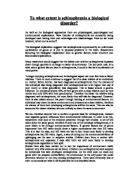We can therefore assume that to confirm a genetic base for schizophrenia, research must separate genetic influences from environmental influences. In order to do this, researchers must look at the evidence presented through twin studies. A set of MZ twins share the same genes, therefore if only one of the develops schizophrenia, it is more likely to be through environmental factors. If genetic factors are of prime importance then MZ twins should show a higher concordance rate than DZ twins. This is in fact the case, and MZ twins are two to four times more likely to develop schizophrenia than DZ twins. Again, a way of cutting out the environmental factor of upbringing can be seen in adoption studies. Children born from a mother with schizophrenia and separated 3 days after birth are still more likely to develop schizophrenia regardless to their split.
Studies have also been carried out to test the importance of environment itself, however very little evidence can be found. Children (non schizophrenic) were adopted by individuals that later developed schizophrenia. As the child does not share any genes with the adopted mother/father, the environment is the only point that could determine whether or not they develop schizophrenia. There were extremely low or even no concordance rates in all studies like the one described above.
Physiological factors can also be researched with reference to the above question. The most important area of research is focused around the brain. In looking at biochemistry, the dopamine hypothesis provides much evidence. This hypothesis states that schizophrenia may result from excess dopamine activity at certain synaptic sites. To support this hypothesis, researchers look at the effect of drugs. One drug in particular, phenothiazines, provide great evidence. These antipsychotics drugs are taken to decrease the severity of thought disorders, alleviate withdrawal and hallucinations, and improve the mood of patients with schizophrenia. Evidence shows that the phenothiazines reduce dopamine activity in the brain by blocking dopamine receptor sites in postsynaptic neurons. This drug that blocks dopamine receptors and used to cure schizophrenia can be compared against other drugs that increase dopamine availability and increase the likelihood of schizophrenia.
We can therefore conclude that such evidence obviously supports the idea that excess dopamine may cause schizophrenic symptoms. However, the dopamine hypothesis does have its downfalls. One in four schizophrenics being prescribed with phenothiazines show very little sign of improvement.
Neurological findings also suggest that individuals with schizophrenia display characteristics associated with neuronal loss or deterioration in a structurally abnormal brain. This only accounts however for those individuals that do not show positive symptoms of schizophrenia such as delusions and hallucinations. Neurological abnormalities tend to be reported more often in people with schizophrenia than in other individuals and more often in patients with negative symptoms if schizophrenia. At best, however, these differences are subtle. The observations are intriguing because they highlight the possibility that some subtypes of schizophrenia may be caused by structural brain pathology. Findings that abnormalities in the prefrontal cortex may be a factor are especially interesting because this area is involved with some of the intellectual symptoms associated with schizophrenia.
Interpreting the findings is problematic, however. These neurological abnormalities do not seem to be specific to schizophrenia. They are also found in some healthy individuals, and in persons with mood disorders, alcohol and substance abuse, and organic impairment. It could therefore be an un-reliable source of evidence.
In conclusion, the above evidence does suggest that schizophrenia is hugely influenced around biology. However, I also stated the amount of alternative approaches to schizophrenia, which may as well provide similar strong supporting evidence.
STUART SMALL
13-JB







